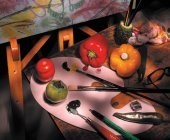|
Flash Light MeterFlash light meter takes exposure reading of a studio flash light. This meter is designed to give quick response to the burst of a studio or camera flash light, which may be for as low as 1/30000 of a second. Analog flash meter displays aperture - F number value with a pointer. A digital flash meter shows F number on an LCD screen and can display one-tenth of F stop reading.
This meter can be used for reflected light or incident light readings. Most of these meters can be switched to ambient light reading mode, and can be used as an hand held exposure meter. Advance models also have spot light reading facility or we can connect an external spot meter attachment on the meter. Some models can give readings of multiple flash light, means that if we fire a flash light for five times on the same subject, the meter will give the information (collectively) on aperture settings, required for five flash bursts.
Top of the line models have a memory option. This option will memorize the first (say high light) reading and then we can take second reading from shadow area. Second reading also will be memorized and upon pressing an "average" button, the meter will show average reading of both brightness, and the required aperture setting. These meters also have dual ISO setting. This is a useful feature when we are using two cameras with different ISO ratting films. Flash meter can have option to display exposure value as an EV number.
All flash meters have an ISO setting, which has to be set as per the camera ISO ratting or the film ISO, which we are using. Read about: How to use a flash meter to measure light Also read about: How to measure light with exposure meter
Return back to Exposure from Flash light meter
|






